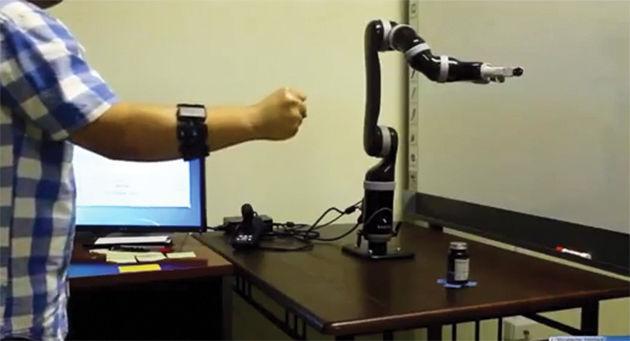Imagine a robot that can be controlled by brain signals. This is exactly what researchers are developing Texas A&M’s Engineering Department.
Mechanical engineering researchers at A&M are designing a robotic exoskeleton performing Myoelectric Interfacing — a process where sensors read electrical signals from the brain to control muscles and replicate movements on a robotic device. This emerging technology could open up new doors in healthcare by providing improved prosthetics and may be the foundation of a new motion input device — similar to the Xbox Kinect.
Sungtae Shin, mechanical engineering Ph.D. candidate, has been studying myoelectric interfacing for more than two years. He said the concept behind this device is not complex, but the science is.
“The muscles emit a small voltage across the nerves, approximately 10 milliVolts,” Sungtae said. “This voltage is later amplified to the sensors in the device that the person wears. Then the exoskeleton will enable rehabilitation activity.”
Sungtae has developed a machine that operates based on a few muscle gestures in the arm. Sungtae said he was interested in this technology because of his passion for computers.
“I was interested in computer technology and artificial intelligence, hence why myoelectric signaling was very attractive to me,” Sungtae said. “This technology is important because it makes it possible for us to control machines using human gestures.”
Reza Langari, head of the Laboratory for Control, Robotics and Animation and the Engineering Technology and Industrial Distribution Department, said this new myoelectric technology is fascinating to research and has a strong potential to grow.
“The way this technology works is that there is a sensor that picks up electrical activity from the brain and from various nerve paths,” Langari said. “This is similar to EEG signaling.”
EEG signaling — which is short for electroencephalogram — is a method to record electrical activity in the brain from the scalp.
Jill Lyster, senior administrative coordinator for engineering technology, said the engineering department has a lot more testing and developing to do before this technology becomes marketable.
Sungtae said he hopes after he leaves, the research will continue on and this technology take off in the future.
“The professors at Texas A&M provided me a lot of help by providing a lot of devices and technical advice,” Sungtae said. “This technology is very interesting and the applications are endless.”








